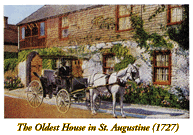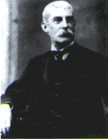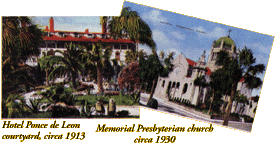|

This is where Florida vacations started!
 The mainland of the North American continent was first sighted by the Spanish explorer and treasure hunter Don Juan Ponce de Leon on Easter, March 27, 1513. He claimed the land for Spain and named it La Florida, meaning "Land of Flowers". Between 1513 and 1563 the government of Spain launched six expeditions to settle Florida, but all failed. the French succceeded in establishing a fort and colony on the St. Johns River in 1564 and, in doing so, threatened Spain's treasure fleets which sailed along Florida's shoreline returning to Spain. As a result of this incursion into Florida, King Phillip the II named Don Pedro Menendez de Aviles, Spain's most experienced admiral, as governor of Florida, instructing him to explore and to colonize the territory. Menendez was also instructed to drive out any pirates or settlers of other nations, should they be found there. The mainland of the North American continent was first sighted by the Spanish explorer and treasure hunter Don Juan Ponce de Leon on Easter, March 27, 1513. He claimed the land for Spain and named it La Florida, meaning "Land of Flowers". Between 1513 and 1563 the government of Spain launched six expeditions to settle Florida, but all failed. the French succceeded in establishing a fort and colony on the St. Johns River in 1564 and, in doing so, threatened Spain's treasure fleets which sailed along Florida's shoreline returning to Spain. As a result of this incursion into Florida, King Phillip the II named Don Pedro Menendez de Aviles, Spain's most experienced admiral, as governor of Florida, instructing him to explore and to colonize the territory. Menendez was also instructed to drive out any pirates or settlers of other nations, should they be found there.
 hen Menendez arrived off the coast of Florida, it was August 28, 1565, the Feast Day of St. Augustine. Eleven days later, he and his 600 soldiers and settlers came ashore at the site of the Timucuan Indian village of Seloy with banners flying and trumpets sounding. He hastily fortified the fledgling village and named it St. Augustine. hen Menendez arrived off the coast of Florida, it was August 28, 1565, the Feast Day of St. Augustine. Eleven days later, he and his 600 soldiers and settlers came ashore at the site of the Timucuan Indian village of Seloy with banners flying and trumpets sounding. He hastily fortified the fledgling village and named it St. Augustine.
Utilizing brilliant military maneuvers, Menendez destroyed the French garriso n on the St. Johns River and, with the help of a hurricane, also defeated the French fleet. With the coast of Florida firmly in Spanish hands, he then set to work building the town, establishing missions to the Indians for the Church, and exploring the land. n on the St. Johns River and, with the help of a hurricane, also defeated the French fleet. With the coast of Florida firmly in Spanish hands, he then set to work building the town, establishing missions to the Indians for the Church, and exploring the land.
Thus, St. Augustine was founded forty-two years before the English colony at Jamestown, Virginia, and fifty-five years before the Pilgrims landed on Plymouth Rock in Massachusetts - making it the oldest permanent European settlement on the North American continent.
 The Charm of Europe on the Coast of Florida The Charm of Europe on the Coast of Florida
Maintaining St. Augustine became a mighty task over the next two hundred years. In 1586, English corsair Sir Francis Drake attacked and burned the town. Then in 1668, the pirate Captain John Davis plundered the town, killing sixty inhabitants. Without the courage, perseverance and faith of its early settlers it is doubtful that St. Augustine would have survived.
Finally, after the British established colonies in Georgia and the Carolinas, Spain authorized the building of a stone fort to protect St. Augustine as assaults from the north became more frequent. The Castillo de San Marcos took twenty-three years to build but, once in place, stood as the town's stalwart defender. Major attacks were made against her in 1702 by Governor James Moore of South Carolina and in 1740 by General James Oglethorpe of Georgia. Neither seige was successful, however, and to this day, the fort has never fallen to enemy attack.

It was not until 1763 that Spain ceded Florida to England in order to regain the capital of Cuba, ushering in twenty years of British rule in Florida. This period coincided with the American Revolution, during which Florida remained loyal to the Crown. In 1783, under the Treaty of Paris, Florida was returned to Spanish rule for a period of thirty-seven years. The Spanish departed for the last time when Spain sold Florida to the United States of America. At a colorful military ceremony on July 10, 1821, US troops took possession of the territory and Spain relinquished control of Florida forever. Cuba, ushering in twenty years of British rule in Florida. This period coincided with the American Revolution, during which Florida remained loyal to the Crown. In 1783, under the Treaty of Paris, Florida was returned to Spanish rule for a period of thirty-seven years. The Spanish departed for the last time when Spain sold Florida to the United States of America. At a colorful military ceremony on July 10, 1821, US troops took possession of the territory and Spain relinquished control of Florida forever.

Soon after the American occupation, St. Augustine suffered a series of setbacks. In 1821, a yellow fever epidemic brought death to many newcomers. Also, uprisings by the Seminole Indians culminated in the Seminole War of 1836, which called a halt to development of St. Augustine's economy.
There's no other place in America like it!
In 1845, Florida became the twenty-seventh state admitted to the Union. The Castillo de San Marcos was renamed Fort Marion in honor of a Revolutionary War hero, and the capital of East Florida was moved from St. Augustine to become part of the state capital in the new town of Tallahassee.
The town had finally begun to prosper when the American Civil War broke out in 1861. Although Florida had seceded with the rest of the Confederacy, St. Augustine was occupied by Union troops throughout most of the conflict. When the war ended in 1865, the town was three centuries old. The war's end brought speculators and land developers to Florida along with the beginnings of the visitor industry.

 n the 1880's, the sleepy old Spanish town began to bustle with the arrival of Henry M. Flagler, who developed the town as a major resort for the leisure traveler. It was during the Flagler era that the minds of St. Augustine residents turned to the leisure life. North Beach and Anastasia Island were explored and quickly became popular destinations. The St. Augustine Golf n the 1880's, the sleepy old Spanish town began to bustle with the arrival of Henry M. Flagler, who developed the town as a major resort for the leisure traveler. It was during the Flagler era that the minds of St. Augustine residents turned to the leisure life. North Beach and Anastasia Island were explored and quickly became popular destinations. The St. Augustine Golf Club operated a golf course on the grounds of the fort, and buses transported guests from the Hotel Ponce de Leon to another golf course north of town. Yacht racing became another popular winter pastime, as overseen by the St. Augustine Yacht Club. Flagler's vision would forever change the face of St. Augustine, but natural disaster also altered the town's appearance. In 1887 and 1914, fires wiped out many historic buildings between the plaza and the north city gates. Club operated a golf course on the grounds of the fort, and buses transported guests from the Hotel Ponce de Leon to another golf course north of town. Yacht racing became another popular winter pastime, as overseen by the St. Augustine Yacht Club. Flagler's vision would forever change the face of St. Augustine, but natural disaster also altered the town's appearance. In 1887 and 1914, fires wiped out many historic buildings between the plaza and the north city gates.
Beginning in 1959, and continuing today, the state has an ongoing preservation effort, meticulously restoring many colonial structures to their original appearance, and historic St. Augustine has become a center of colonial Spanish culture and an important destination for travelers from all parts of the world.
The Henry Flagler Era
 The arrival of Henry Flagler in 1885 marked the beginning of a golden era for St. Augustine that extended through 1914. Enticed by the city's temperate climate and unique ambiance, Flagler saw great potential for St. Augustine as a popular winter resort and playground for rich Northerners. a co-founder of the Standard Oil Company with John D. Rockefeller, he immediately put his vast fortune to work building his dream. He constructed two lavish hotels, the beautiful Alcazar, and his masterpiece-the Ponce de Leon. The arrival of Henry Flagler in 1885 marked the beginning of a golden era for St. Augustine that extended through 1914. Enticed by the city's temperate climate and unique ambiance, Flagler saw great potential for St. Augustine as a popular winter resort and playground for rich Northerners. a co-founder of the Standard Oil Company with John D. Rockefeller, he immediately put his vast fortune to work building his dream. He constructed two lavish hotels, the beautiful Alcazar, and his masterpiece-the Ponce de Leon.
 These hotels allowed St. Augustine to accommodate the wealthiest of travelers with luxurious lodgings and a fine array of leisure activities. His Florida East Coast Railway ensured a transportation link between New York and St. Augustine, and he built a two-story depot to properly receive arriving guests. Flagler was also responsible for building the town's hospital, city hall, and several churches. Flagler expanded his dream south toward Palm Beach when he moved there in the early 1900's, but had given St. Augustine an era of prestige and prosperity - the effects of which are still evident today. These hotels allowed St. Augustine to accommodate the wealthiest of travelers with luxurious lodgings and a fine array of leisure activities. His Florida East Coast Railway ensured a transportation link between New York and St. Augustine, and he built a two-story depot to properly receive arriving guests. Flagler was also responsible for building the town's hospital, city hall, and several churches. Flagler expanded his dream south toward Palm Beach when he moved there in the early 1900's, but had given St. Augustine an era of prestige and prosperity - the effects of which are still evident today.

Pages Written by Allan C. Reichert
Randolph Caldecott Society of America
Updated on 3/24/02 |
 The Charm of Europe on the Coast of Florida
The Charm of Europe on the Coast of Florida

 The mainland of the North American continent was first sighted by the Spanish explorer and treasure hunter Don Juan Ponce de Leon on Easter, March 27, 1513. He claimed the land for Spain and named it La Florida, meaning "Land of Flowers". Between 1513 and 1563 the government of Spain launched six expeditions to settle Florida, but all failed. the French succceeded in establishing a fort and colony on the St. Johns River in 1564 and, in doing so, threatened Spain's treasure fleets which sailed along Florida's shoreline returning to Spain. As a result of this incursion into Florida, King Phillip the II named Don Pedro Menendez de Aviles, Spain's most experienced admiral, as governor of Florida, instructing him to explore and to colonize the territory. Menendez was also instructed to drive out any pirates or settlers of other nations, should they be found there.
The mainland of the North American continent was first sighted by the Spanish explorer and treasure hunter Don Juan Ponce de Leon on Easter, March 27, 1513. He claimed the land for Spain and named it La Florida, meaning "Land of Flowers". Between 1513 and 1563 the government of Spain launched six expeditions to settle Florida, but all failed. the French succceeded in establishing a fort and colony on the St. Johns River in 1564 and, in doing so, threatened Spain's treasure fleets which sailed along Florida's shoreline returning to Spain. As a result of this incursion into Florida, King Phillip the II named Don Pedro Menendez de Aviles, Spain's most experienced admiral, as governor of Florida, instructing him to explore and to colonize the territory. Menendez was also instructed to drive out any pirates or settlers of other nations, should they be found there. hen Menendez arrived off the coast of Florida, it was August 28, 1565, the Feast Day of St. Augustine. Eleven days later, he and his 600 soldiers and settlers came ashore at the site of the Timucuan Indian village of Seloy with banners flying and trumpets sounding. He hastily fortified the fledgling village and named it St. Augustine.
hen Menendez arrived off the coast of Florida, it was August 28, 1565, the Feast Day of St. Augustine. Eleven days later, he and his 600 soldiers and settlers came ashore at the site of the Timucuan Indian village of Seloy with banners flying and trumpets sounding. He hastily fortified the fledgling village and named it St. Augustine. n on the St. Johns River and, with the help of a hurricane, also defeated the French fleet. With the coast of Florida firmly in Spanish hands, he then set to work building the town, establishing missions to the Indians for the Church, and exploring the land.
n on the St. Johns River and, with the help of a hurricane, also defeated the French fleet. With the coast of Florida firmly in Spanish hands, he then set to work building the town, establishing missions to the Indians for the Church, and exploring the land.
 Cuba, ushering in twenty years of British rule in Florida. This period coincided with the American Revolution, during which Florida remained loyal to the Crown. In 1783, under the Treaty of Paris, Florida was returned to Spanish rule for a period of thirty-seven years. The Spanish departed for the last time when Spain sold Florida to the United States of America. At a colorful military ceremony on July 10, 1821, US troops took possession of the territory and Spain relinquished control of Florida forever.
Cuba, ushering in twenty years of British rule in Florida. This period coincided with the American Revolution, during which Florida remained loyal to the Crown. In 1783, under the Treaty of Paris, Florida was returned to Spanish rule for a period of thirty-seven years. The Spanish departed for the last time when Spain sold Florida to the United States of America. At a colorful military ceremony on July 10, 1821, US troops took possession of the territory and Spain relinquished control of Florida forever.

 n the 1880's, the sleepy old Spanish town began to bustle with the arrival of Henry M. Flagler, who developed the town as a major resort for the leisure traveler. It was during the Flagler era that the minds of St. Augustine residents turned to the leisure life. North Beach and Anastasia Island were explored and quickly became popular destinations. The St. Augustine Golf
n the 1880's, the sleepy old Spanish town began to bustle with the arrival of Henry M. Flagler, who developed the town as a major resort for the leisure traveler. It was during the Flagler era that the minds of St. Augustine residents turned to the leisure life. North Beach and Anastasia Island were explored and quickly became popular destinations. The St. Augustine Golf Club operated a golf course on the grounds of the fort, and buses transported guests from the Hotel Ponce de Leon to another golf course north of town. Yacht racing became another popular winter pastime, as overseen by the St. Augustine Yacht Club. Flagler's vision would forever change the face of St. Augustine, but natural disaster also altered the town's appearance. In 1887 and 1914, fires wiped out many historic buildings between the plaza and the north city gates.
Club operated a golf course on the grounds of the fort, and buses transported guests from the Hotel Ponce de Leon to another golf course north of town. Yacht racing became another popular winter pastime, as overseen by the St. Augustine Yacht Club. Flagler's vision would forever change the face of St. Augustine, but natural disaster also altered the town's appearance. In 1887 and 1914, fires wiped out many historic buildings between the plaza and the north city gates. The arrival of
The arrival of  These hotels allowed St. Augustine to accommodate the wealthiest of travelers with luxurious lodgings and a fine array of leisure activities. His Florida East Coast Railway ensured a transportation link between New York and St. Augustine, and he built a two-story depot to properly receive arriving guests. Flagler was also responsible for building the town's hospital, city hall, and several churches. Flagler expanded his dream south toward Palm Beach when he moved there in the early 1900's, but had given St. Augustine an era of prestige and prosperity - the effects of which are still evident today.
These hotels allowed St. Augustine to accommodate the wealthiest of travelers with luxurious lodgings and a fine array of leisure activities. His Florida East Coast Railway ensured a transportation link between New York and St. Augustine, and he built a two-story depot to properly receive arriving guests. Flagler was also responsible for building the town's hospital, city hall, and several churches. Flagler expanded his dream south toward Palm Beach when he moved there in the early 1900's, but had given St. Augustine an era of prestige and prosperity - the effects of which are still evident today.